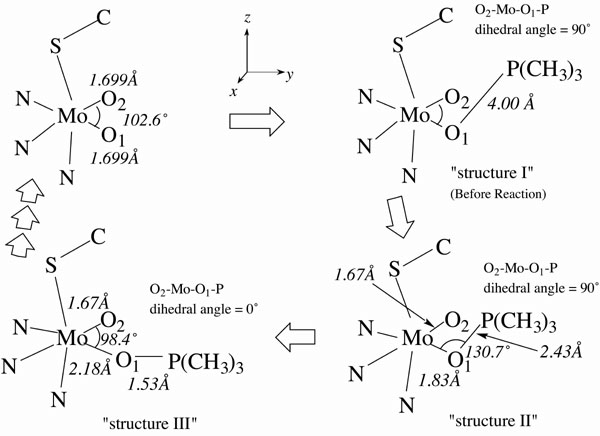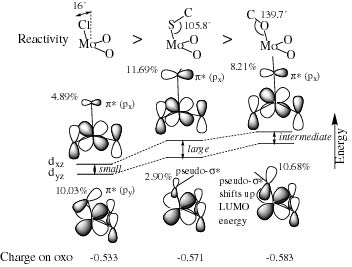

Ligand K-edge and Metal L-edge X-Ray Absorption Spectroscopy and Density Functional Calculations of Oxomolybdenum Complexes with Thiolate and Related Ligands |
Y. Izumi, T. Glaser, K. Rose, J. McMaster, P. Basu, J. H. Enemark,
B. Hedman, K. O. Hodgson, and E. I. Solomon,
J. Am. Chem. Soc., 10035 - 10046, 121 (1999).
X-ray absorption spectra have been measured at S K-, Cl K-, and Mo L3- and L2-edges for the d0 dioxomolybdenum complexes, LMoO2(SCH2Ph), LMoO2Cl, and LMoO2(OPh) (L = hydrotris(3,5-dimethyl-1-pyrazolyl)borate) to investigate ligand-metal covalency and its effects on oxo transfer reactivity. Two dominant peaks are observed at the S K-edge (2470.5 and 2472.5 eV) of LMoO2(SCH2Ph) and at the Cl K-edge (2821.9 and 2824.2 eV) of LMoO2Cl, demonstrating two major covalent contributions of S and Cl to the Mo d orbitals. Density functional calculations were performed on models of the three Mo complexes, and the energies and characters of the Mo 4d orbitals were interpreted in terms of the effects of two strong cis-oxo bonds and the additional perturbation due to the thiolate, chloride, or alkoxide ligand. The major perturbation effects are thiolate S pi mixed with the d(xz) orbital and pseudo-sigma with the d(z2) orbital, Cl pi mixed with the d(yz) orbital and sigma with the d(z2) orbital, and alkoxide O pseudo-sigma mixed with the d(yz) orbital and pi with the d(xz) orbital. The calculated energy splittings (2.466 eV for the model of LMoO2(SCH2Ph) and 2.706 eV for the model of LMoO2Cl) of these two major contributions to the bonding correspond to the splitting observed of the two dominant ligand K-edge peaks (1.93 for LMoO2(SCH2Ph) and 2.43 eV for LMoO2Cl) with differences relating to final state electronic relaxation. The Mo L3- and L2-edge spectra for the three Mo complexes contain a strong, broad peak and two additional sharp peaks at higher energy, which are assigned to 2p transitions to the overlapping t(2g) set and to the d(z2) and d(xy) levels, respectively. The Mo L2-edge spectra for the three Mo complexes provide a direct probe of metal 4d character. The total peak intensity of the Mo L2-edges is in the order LMoO2 (OPh) > LMoO2Cl > LMoO2(SCH2Ph), which agrees with the calculated trends in ligand-metal covalency. The theoretical and experimental description of bonding developed from these studies provides insight into the relationship of electronic structure to the oxo transfer chemistry observed for LMoO2X complexes. The implications of these results for the molybdenum center of sulfite oxidase are also discussed.
|
 |
Chiba University > Graduate School of Science > Department of Chemistry > Dr. Yasuo Izumi Group